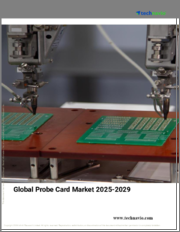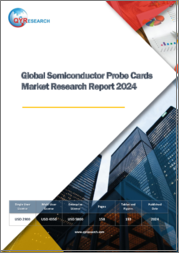
|
시장보고서
상품코드
1618445
세계의 프로브 카드 시장 규모 : 기술별, 용도별, 제품별, 지역별, 범위 및 예측Global Probe Card Market Size By Technology, By Application, By Product, By Geographic Scope And Forecast |
||||||
프로브 카드 시장 규모와 예측
프로브 카드 시장 규모는 2023년에 28억 5,085만 달러로 평가되며, 2024-2030년 CAGR 10.70%로 성장하며, 2030년에는 64억 2,917만 달러에 달할 것으로 예측됩니다. 세계의 프로브 카드 시장 성장 촉진요인 프로브 카드 시장 시장 성장 촉진요인은 다양한 요인의 영향을 받습니다. 반도체 부문의 성장 프로브 카드는 반도체 웨이퍼 제조 공정에서 검사에 필요한 장비이기 때문에 프로브 카드 시장은 반도체 부문에 크게 의존하고 있습니다. 프로브 카드 시장은 가전, 자동차, 사물인터넷을 포함한 다양한 용도에 의해 주도되는 반도체 디바이스에 대한 지속적인 수요에 따라 성장하고 있습니다.
반도체 기술 개발 :
반도체 소자의 소형화, 복잡화 등 반도체 산업의 기술 혁신으로 인해 복잡한 구조를 검사할 수 있는 고성능 프로브 카드에 대한 수요가 증가하고 있습니다. 반도체 기술의 급속한 발전에 대응하기 위해 프로브 카드 제조업체는 끊임없이 창의성을 발휘하여 시장 확대를 추진해야 합니다.
고속 및 고성능 전자제품에 대한 수요 증가:
데이터센터, 인공지능, 통신 등 다양한 산업에서 고속 및 고성능 전자제품의 보급이 증가함에 따라 이러한 첨단 부품을 테스트할 수 있는 프로브 카드에 대한 수요가 증가하고 있습니다. 고주파 및 고속 장비 테스트용으로 설계된 특수 프로브 카드의 탄생은 이러한 요구에 힘입어 탄생했습니다.
반도체 소자의 복잡성 증가:
반도체 디바이스가 복잡해질수록 기능성과 신뢰성을 테스트하기가 더 어려워지며, 3차원 적층 IC, 최첨단 포장 기술 등 복잡한 반도체 아키텍처를 테스트하기 위해서는 프로브 카드의 개발이 필요합니다. 이는 시장 확대에 박차를 가할 것입니다.
MEMS와 센서의 용도 확대:
자동차, 헬스케어, 산업 용도 등 다양한 산업 분야에서 마이크로 전자기계 시스템(MEMS)과 센서의 사용이 증가함에 따라 이러한 특수한 장비를 테스트할 수 있는 프로브 카드에 대한 수요가 증가하고 있습니다. 프로브 카드 제조업체들은 MEMS 및 센서 기술이 발전함에 따라 특정 테스트 요구에 적합한 특수 솔루션을 제공합니다.
자동차용 일렉트로닉스 시장 확대:
인포테인먼트 시스템, ADAS(첨단 운전자 보조 시스템), 전기자동차 기술 등 자동차 산업에서 전자 시스템 및 부품의 통합이 진행됨에 따라 차량용 반도체 테스트에 사용되는 프로브 카드에 대한 수요가 증가하고 있습니다. 자동차 용도 전용으로 설계된 프로브 카드 시장은 자동차용 일렉트로닉스 산업과 함께 성장하고 있습니다.
반도체 개발의 지역적 발전:
이러한 신흥 국가 반도체 시장에서의 프로브 카드 수요는 특히 아시아태평양 등 반도체 제조 시설의 지역적 확장에 힘입어 증가하고 있습니다. 프로브 카드 제조업체들은 새로운 지역에 반도체 제조 공장이 늘어남에 따라 현지 수요를 충족시키기 위해 시장 확대를 추진하고 있습니다.
반도체 검사 서비스 아웃소싱 확대 :
많은 반도체 기업이 비용 절감과 효율성 향상을 위해 테스트 프로세스를 외부 테스트 서비스 프로바이더와 계약하는 것을 선택하고 있습니다. 전체 프로브 카드 시장은 이러한 추세에 따라 테스트 서비스 프로바이더가 사용하는 프로브 카드에 대한 수요가 증가하고 있습니다.
세계의 프로브 카드 시장 성장 억제요인
프로브 카드 시장에는 몇 가지 요인이 억제요인 및 과제로 작용할 수 있습니다. 다음과 같은 요인들이 있습니다.
초기 투자 및 유지보수 비용이 높음
프로브카드 시스템은 특히 복잡한 반도체 소자를 테스트하기 위한 고성능 모델의 경우, 초기 투자비용과 지속적인 유지보수 비용이 많이 듭니다. 높은 소유 비용으로 인해 복잡한 프로브 카드 솔루션에 투자하는 반도체 제조업체(특히 중소형 제조업체)는 많지 않으며, 이는 시장 확대를 제한할 수 있습니다.
기술의 복잡성과 연구개발의 과제:
더 복잡한 반도체 소자를 테스트할 수 있는 첨단 프로브 카드 기술을 개발하기 위해서는 많은 연구개발 노력이 필요합니다. 또한 프로브 카드 제조업체는 변화하는 테스트 표준에 대응하기 위해 지속적으로 개발해야 하므로 반도체 기술의 급속한 발전에 대응하기 어렵습니다. 새로운 프로브카드 솔루션의 출시와 시장 성장은 연구개발의 제약과 기술의 복잡성으로 인해 방해가 될 수 있습니다.
신진 반도체 기술과의 제한적인 상호 운용성:
실리콘 포토닉스, 양자 컴퓨팅, 뉴로모픽 컴퓨팅 등 새로운 반도체 기술이 초래하는 새로운 검사 문제는 현재의 프로브카드 솔루션으로는 완전히 대응할 수 없습니다. 이러한 첨단 기술에 대응하는 프로브 카드를 제작하기 위해서는 전문 지식과 자금이 필요하며, 이러한 자원이 반드시 소비자의 기대에 부합하는 것은 아닙니다. 따라서 프로브 카드가 최첨단 반도체 기술에 대응할 수 있는지 여부가 시장 성장을 제한할 수 있습니다.
신뢰성과 품질에 대한 두 가지 측면의 관심사:
프로브 카드는 제조 공정에서 철저한 테스트를 통해 반도체 소자의 품질과 신뢰성을 보장하는 중요한 역할을 합니다. 프로브 카드의 정확성, 신뢰성 및 내구성 문제는 반도체 수율과 전체 제품 품질에 큰 영향을 미칩니다. 프로브 카드의 마모, 손상, 부정확한 교정 등의 문제는 프로브 카드의 품질 및 신뢰성 문제가 소비자의 신뢰와 시장 수용에 어떻게 영향을 미치는지 보여주는 한 가지 예에 불과합니다.
세계 경제의 불확실성 영향:
세계 경제 상황의 변화는 반도체 산업 전체뿐만 아니라 프로브 카드 시장에도 영향을 미칠 수 있습니다. 경기 침체, 무역 마찰, 지정학적 불확실성 등으로 인한 반도체 시장의 혼란으로 인해 프로브 카드와 같은 제조 장비에 대한 투자가 감소할 수 있습니다. 또한 공급망 중단과 부품 부족으로 인해 시장의 어려움이 심화되어 프로브카드 솔루션에 대한 접근성과 비용에 영향을 미칠 수 있습니다.
규제 및 컴플라이언스 요구사항:
프로브 카드 제조업체는 산업 사양 및 규제 표준을 준수하기 위해 추가 비용을 부담하고 추가 요구 사항을 충족해야 합니다. 이러한 표준의 예로 반도체 제조 장비에 대한 SEMI 표준을 들 수 있습니다. 시장 진출기업은 성능과 신뢰성에 대한 고객의 요구를 충족시키면서 이러한 표준을 준수하는 것은 특히 경영 자원이 부족한 중소기업에게는 어려운 일입니다.
목차
제1장 서론
- 시장의 정의
- 시장 세분화
- 조사 방법
제2장 개요
- 주요 조사 결과
- 시장 개요
- 시장 하이라이트
제3장 시장 개요
- 시장 규모와 성장의 가능성
- 시장 동향
- 시장 성장 촉진요인
- 시장 성장 억제요인
- 시장 기회
- Porter's Five Forces 분석
제4장 프로브 카드 시장 : 기술별
- MEMS 기반 프로브 카드
- CMOS 기반 프로브 카드
- 종형 프로브 카드
제5장 프로브 카드 시장 : 용도별
- 웨이퍼 테스트
- 패키지 테스트
- 디바이스 테스트
제6장 프로브 카드 시장 : 제품별
- 스탠다드 프로브 카드
- 첨단 프로브 카드
- 커스터마이즈 프로브 카드
제7장 지역 분석
- 북미
- 미국
- 캐나다
- 멕시코
- 유럽
- 영국
- 독일
- 프랑스
- 이탈리아
- 아시아태평양
- 중국
- 일본
- 인도
- 호주
- 라틴아메리카
- 브라질
- 아르헨티나
- 칠레
- 중동 및 아프리카
- 남아프리카공화국
- 사우디아라비아
- 아랍에미리트
제8장 시장 역학
- 시장 성장 촉진요인
- 시장 성장 억제요인
- 시장 기회
- 시장에 대한 COVID-19의 영향
제9장 경쟁 구도
- 주요 기업
- 시장 점유율 분석
제10장 기업 개요
- FormFactor Ltd.
- Feinmetall GmbH
- SV Probe
- Microfriend Inc.
- Japan Electronic Materials Corporation
- RIKA DENSHI CO., LTD.
- Precision Test Tech.Co., Ltd.
- MPI Corporation
- MICRONICS JAPAN CO., LTD.
제11장 시장 전망과 기회
- 신규 기술
- 향후 시장 동향
- 투자 기회
제12장 부록
- 약어 리스트
- 전시와 참고 문헌
Probe Card Market Size And Forecast
Probe Card Market size was valued at USD 2850.85 Million in 2023 and is projected to reach USD 6429.17 Million by 2030, growing at a CAGR of 10.70% from 2024 to 2030. Global Probe Card Market Drivers The market drivers for the Probe Card Market can be influenced by various factors. These may include: Growth of the Semiconductor sector: Since probe cards are necessary instruments for inspecting semiconductor wafers during the production process, the probe card market is highly dependent on the semiconductor sector. The probe card market is expanding in accordance with the ongoing demand for semiconductor devices, which is being driven by a variety of applications including consumer electronics, automotive, and the Internet of Things.
Developments in Semiconductor Technology:
The need for sophisticated probe cards that can test these complex structures is driven by the semiconductor industry's technological innovations, which include the creation of smaller and more complicated semiconductor devices. In order to keep up with the rapid advancements in semiconductor technology, probe card producers need to stay creative and drive market expansion.
Growing Need for High-Speed and High-Performance Electronics:
As high-speed and high-performance electronics proliferate across a range of industries, including data centers, artificial intelligence, and telecommunications, there is an increasing demand for probe cards that can test these cutting-edge components. The creation of specific probe cards designed for high-frequency and high-speed device testing is fueled by this need.
Growing Complexity of Semiconductor devices:
It gets harder to test semiconductor devices for functionality and reliability as they get more complicated. In order to test complex semiconductor architectures, such as 3D stacked ICs and cutting-edge packaging technologies, probe cards must develop. This will spur market expansion.
Expanding Use of MEMS and Sensors:
The need for probe cards that can test these specialized devices is fueled by the increasing use of micro-electromechanical systems (MEMS) and sensors in a variety of industries, including the automotive, healthcare, and industrial applications. Manufacturers of probe cards provide specialized solutions suited to their particular testing needs as MEMS and sensor technologies progress.
Market Expansion for Automotive Electronics:
The need for probe cards, which are used to test automotive semiconductors, is driven by the automotive industry's growing integration of electronic systems and components, such as infotainment systems, advanced driver-assistance systems (ADAS), and electric vehicle technologies. The market for probe cards designed specifically for automotive applications is growing together with the automotive electronics industry.
Geographical development of Semiconductor Manufacturing:
The need for probe cards in these developing semiconductor markets is boosted by the geographic development of semiconductor manufacturing facilities, especially in areas like Asia-Pacific. Manufacturers of probe cards aim to expand their reach in order to meet local demand as semiconductor fabs multiply in new areas, hence fostering market expansion.
Growing Outsourcing of Semiconductor Testing Services:
In an effort to cut expenses and improve efficiency, a lot of semiconductor businesses choose to contract with outside testing service providers for their testing procedures. The market for probe cards as a whole is driven by this trend, which increases the need for the cards used by testing service providers.
Global Probe Card Market Restraints
Several factors can act as restraints or challenges for the Probe Card Market. These may include:
High Initial Investment and Maintenance expenses:
Probe card systems can have a significant initial investment and continuing maintenance expenses, especially for the more sophisticated models intended to test intricate semiconductor devices. Due to the high cost of ownership, fewer semiconductor manufacturers-particularly smaller ones-may choose to invest in complex probe card solutions, which could restrict market expansion.
Technological Complexity and R&D Challenges:
Significant research and development (R&D) efforts are needed to create sophisticated probe card technologies that can test more complicated semiconductor devices. Additionally, makers of probe cards face difficulties in keeping up with the quick advances in semiconductor technology because they have to constantly develop in order to meet changing testing criteria. The launch of new probe card solutions and market growth may be impeded by the accompanying R&D constraints and technological complexity.
Limited Interoperability with Up-and-Coming Semiconducting Technology:
Novel testing problems are brought about by emerging semiconductor technologies including silicon photonics, quantum computing, and neuromorphic computing, which could not be entirely satisfied by current probe card solutions. It takes specialized knowledge and financial resources to create probe cards for these cutting-edge technologies, and these resources might not always match consumer expectations. Therefore, the ability of probe cards to work with cutting-edge semiconductor technologies may limit the growth of the market.
Both dependability and quality Concerns:
By carrying out thorough testing during the manufacturing process, probe cards serve a vital role in guaranteeing the quality and dependability of semiconductor devices. Probe card accuracy, dependability, and durability problems can have a big impact on semiconductor yield and overall product quality. Problems with probe wear, damage, and inaccurate calibration are just a few examples of how problems with probe cards' quality and dependability can affect consumer confidence and market acceptance.
Impact of Global Economic Uncertainty:
Changes in the state of the world economy can have an impact on the probe card market as well as the semiconductor industry as a whole. Reduced investments in manufacturing equipment, such as probe cards, might result from disruptions in the market for semiconductors caused by economic downturns, trade conflicts, and geopolitical uncertainty. Furthermore, market difficulties may be made worse by supply chain interruptions and component shortages, which may affect the accessibility and cost of probe card solutions.
Regulatory and Compliance Requirements:
Probe card makers must incur additional costs and meet additional requirements in order to comply with industry specifications and regulatory standards. Examples of these standards are SEMI standards for semiconductor production equipment. It can be difficult for market participants to ensure adherence to these standards while satisfying customer needs for performance and dependability, especially for smaller businesses with limited resources.
Global Probe Card Market Segmentation Analysis
Global Probe Card Market is segmented based on Technology, Application, Product And Geography.
Probe Card Market, By Technology
- MEMS-based Probe Cards
- : These probe cards incorporate micro-electromechanical systems (MEMS) technology for improved precision and performance in testing semiconductor devices.
- CMOS-based Probe Cards
- : Complementary metal-oxide-semiconductor (CMOS) technology is utilized in these probe cards to enhance functionality and integration.
- Vertical Probe Cards
- : Vertical probe cards feature vertically oriented probe needles for testing semiconductor wafers, offering advantages such as reduced contact resistance and improved signal integrity.
Probe Card Market, By Application
- Wafer Test
- : Probe cards used for testing semiconductor wafers during the manufacturing process to ensure functionality and reliability.
- Package Test
- : Probe cards employed for testing semiconductor packages, including advanced packaging technologies such as flip-chip and system-in-package (SiP).
- Device Test
- : Probe cards utilized for testing individual semiconductor devices, including discrete components and integrated circuits (ICs).
Probe Card Market, By Product
- Standard Probe Cards
- : Conventional probe cards designed for general-purpose testing applications across various semiconductor devices and technologies.
- Advanced Probe Cards
- : High-performance probe cards equipped with advanced features and capabilities for testing complex semiconductor structures and emerging technologies.
- Customized Probe Cards
- : Tailor-made probe cards developed to meet specific customer requirements, including specialized testing applications and unique semiconductor designs.
Probe Card Market, By Geography
- North America:
- Market conditions and demand in the United States, Canada, and Mexico.
- Europe:
- Analysis of the Probe Card Market in European countries.
- Asia-Pacific:
- Focusing on countries like China, India, Japan, South Korea, and others.
- Middle East and Africa:
- Examining market dynamics in the Middle East and African regions.
- Latin America:
- Covering market trends and developments in countries across Latin America.
Key Players
- The major players in the Probe Card Market are:
- FormFactor Ltd.
- Feinmetall GmbH
- SV Probe
- Microfriend Inc.
- Japan Electronic Materials Corporation
- RIKA DENSHI CO. LTD
- Precision Test Tech.Co. Ltd
- MPI Corporation
- MICRONICS JAPAN CO. LTD
TABLE OF CONTENTS
1. Introduction
- Market Definition
- Market Segmentation
- Research Methodology
2. Executive Summary
- Key Findings
- Market Overview
- Market Highlights
3. Market Overview
- Market Size and Growth Potential
- Market Trends
- Market Drivers
- Market Restraints
- Market Opportunities
- Porter's Five Forces Analysis
4. Probe Card Market, By Technology
- MEMS-based Probe Cards
- CMOS-based Probe Cards
- Vertical Probe Cards
5. Probe Card Market, By Application
- Wafer Test
- Package Test
- Device Test
6. Probe Card Market, By Product
- Standard Probe Cards
- Advanced Probe Cards
- Customized Probe Cards
7. Regional Analysis
- North America
- United States
- Canada
- Mexico
- Europe
- United Kingdom
- Germany
- France
- Italy
- Asia-Pacific
- China
- Japan
- India
- Australia
- Latin America
- Brazil
- Argentina
- Chile
- Middle East and Africa
- South Africa
- Saudi Arabia
- UAE
8. Market Dynamics
- Market Drivers
- Market Restraints
- Market Opportunities
- Impact of COVID-19 on the Market
9. Competitive Landscape
- Key Players
- Market Share Analysis
10. Company Profiles
- FormFactor Ltd.
- Feinmetall GmbH
- SV Probe
- Microfriend Inc.
- Japan Electronic Materials Corporation
- RIKA DENSHI CO., LTD.
- Precision Test Tech.Co., Ltd.
- MPI Corporation
- MICRONICS JAPAN CO., LTD.
11. Market Outlook and Opportunities
- Emerging Technologies
- Future Market Trends
- Investment Opportunities
12. Appendix
- List of Abbreviations
- Sources and References



















